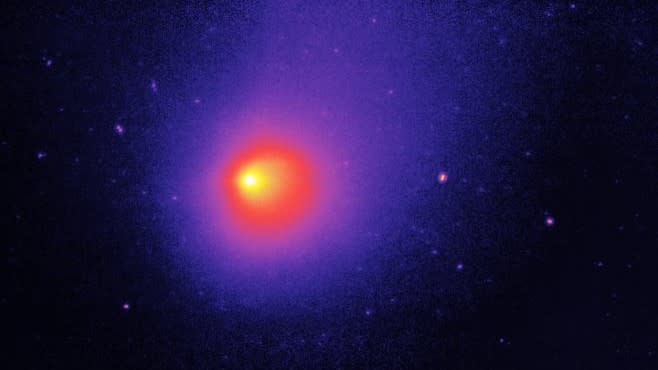In a 1st, scientists predicted that volcanic comet was due to pop 'like a Champagne bottle' — and it did


Astronomers recently rejoiced after witnessing a bizarre volcanic comet erupt like a "Champagne bottle," spraying gas and ice through the solar system like sparkling wine. The unusual explosion was a cause for celebration because, for the first time, the researchers successfully predicted it was going to happen.
The volatile comet, known as 29P/Schwassmann-Wachmann (29P), is around 37 miles (60 kilometers) wide and takes around 14.9 years to orbit the sun. As well as being volcanic, 29P has an unusually circular orbit for a comet and rotates much more slowly than expected. It is one of around 100 comets, known as "centaurs," that have been pushed from the Kuiper Belt — a ring of icy comets that lurk beyond Neptune — into a closer orbit around the sun nearer Jupiter.
Unlike volcanoes on Earth, which eject scalding-hot magma and ash from the planet's mantle, 29P spits out extremely cold gases and ice from its supercold interior. This unusual type of volcanic activity is known as cryovolcanism, or "cold volcanism."
On April 2, scientists from the British Astronomical Association (BAA) observed a sharp spike in 29P's brightness, which was caused by light reflecting off recently ejected gas and ice, or cryomagma, in the comet's coma — the cloud of gas that surrounds a comet's body, or nucleus. The eruption was likely quite sizable given that the coma outshone the nucleus by a factor of more than 10, Spaceweather.com reported, but its exact strength has not yet been quantified.
The eruption was "like a cork popping from a champagne bottle," according to Spaceweather.com.
Related: Gigantic 'alien' comet spotted heading straight for the sun

29P is one of the most volcanically active comets in the solar system, and researchers have seen it blow its top hundreds of times before. In November 2022, the icy comet experienced a massive eruption that spewed out more than 1 million tons of cryomagma, making it the second-largest explosion of its kind recorded in the last 12 years. But, like with all other past eruptions from 29P, astronomers had no idea that the huge eruption was imminent before it happened.
However, this time, researchers strongly suspected that 29P was going to erupt.
Cryovolcanic bodies, which include a handful of other comets and several solar system moons such as Saturn's Enceladus, Jupiter's Europa and Neptune's Triton, have a surface crust surrounding a mainly solid icy core, Richard Miles, a BAA astronomer who has studied 29P, told Live Science last year. Over time, radiation from the sun can cause a comet's icy interior to sublime from solid to gas, which causes a buildup of pressure beneath the crust, although some gas continually leaks out at the same time. When radiation from the sun weakens the crust, that pressure causes the outer shell to crack, and cryomagma shoots out into space.
RELATED STORIES
—Bright new comet discovered zooming toward the sun could outshine the stars next year
—Optical illusion gives rare green comet an ‘anti-tail’ that seemingly defies physics
—Blazing comet tail is whipped by solar winds in astonishing astronomy photo
On April 1, BAA astronomers noticed that the light surrounding the comet's nucleus was "the faintest we have ever seen it," Miles wrote in a statement. This was a sign that less gas was leaking out from the comet's outer crust than usual, suggesting pressure was building up at an increased rate within the comet, he added. This made an eruption "highly likely to happen."
The latest eruption is proof that 29P's eruptions can be predicted in advance, which will hopefully help researchers to study future eruptions in greater detail.
